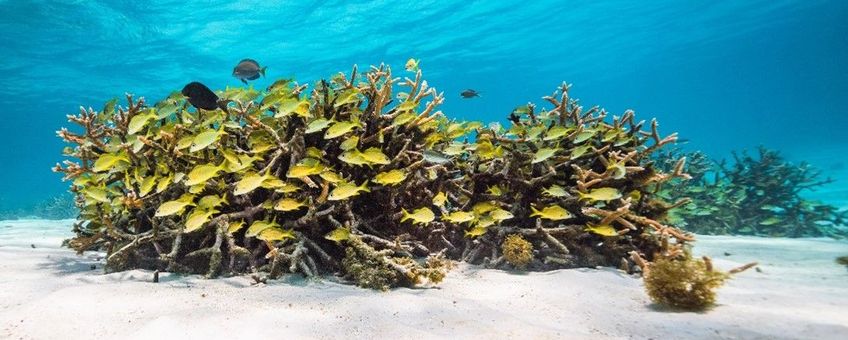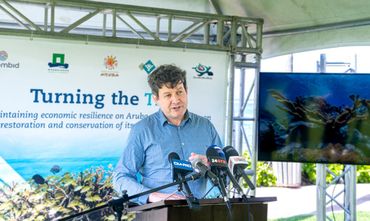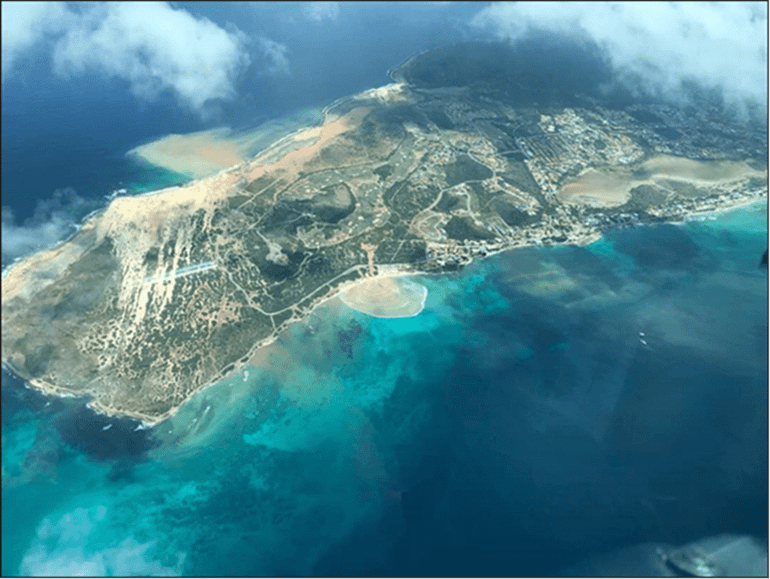
‘Turning the Tide’ for mangrove and coral in Aruba
Dutch Caribbean Nature Alliance (DCNA), Aruba National Park Foundation, University of Aruba, Wageningen University & ResearchAccording to WWF Fund for Nature’s Living Planet Report 2022, the biodiversity loss by region is declining far greater across Latin America and the Caribbean than any other region. A 94 percent decrease of biodiversity was seen between 1970 and 2018. The 5th and 6th national reports of the Netherlands (pdf: 10.0 MB) for the Convention on Biological Diversity also reported a disturbing message on the condition of the marine environment in the Dutch Caribbean with the conservation status being insufficient with no measurable positive change.
Because the economy of our Caribbean islands is largely dependent on healthy and rich nature, the loss of biodiversity is also at the expense of economic sectors, such as tourism and fishing. For example, a 2018 study into the value of Aruban nature (pdf: 12.2 MB) concluded that the degradation of the marine environment could lead to a halving of prosperity. It is therefore crucial for people and nature to stop this decline and to turn the tide from biodiversity loss to biodiversity recovery.
How do we solve the problem?

To start solving this problem on a national level it is important that it is recognized in the Aruban policy notes and plans. The seriousness of unsustainable development and the loss of ecosystem services is reflected in the Nature and Environment policy note 2018–2021 (in Dutch; pdf: 15.7 MB), the Economic Policy 2019–2021, the National Strategic Plan 2020-2022 (pdf: 5.8 MB) and the SDG Roadmap (pdf: 3.0 MB).
In addition to nice words, this awareness has also led to actions, such as the establishment in 2018 of the marine nature reserve 'Parke Marino Aruba' in parts of the coastal area. In addition, Minister Ursell Arends, responsible for nature, made a commitment on behalf of Aruba at the United Nations Oceans Conference in June 2022 to create a marine park around the entire island, and a process is also underway to make the vast majority of the coastal area accessible. to be designated as a protected wetland under the Ramsar Convention. Not without reason, because the island still has a rich biodiversity, including mangrove forests, seagrass fields, coral reefs, laying beaches for four species of sea turtles, breeding islands for ten species of terns and shallow lagoons where six different species of dolphins can be regularly observed.
Protection on paper is a good first step, but ultimately it comes down to action. For the Parke Marino Aruba, manager Fundacion Parke Nacional Aruba (FPNA) is currently finalizing the management plan. A plan that has been drawn up in consultation with more than sixty different Aruban stakeholders. However, the necessary repair and management activities require a substantial investment. Because the own resources are insufficient for this, external funds are being sought.
The many years of collaboration with Wageningen University & Research offered a solution. The Turning the Tide project worth more than 700,000 euros has been developed in partnership with the University of Aruba and NGO ScubbleBubbles. This has been funded through the EU's RESEMBID programme, for European overseas territories in the Caribbean. The recent award of this project has led to many enthusiastic reactions and media attention in Aruba.
What does the project entail?
The project mainly concerns the restoration of mangrove forests and coral reefs. This recovery will be monitored by students from the Universities of Aruba and Wageningen. For awareness purposes and because of the importance for other Caribbean islands, communication of the results achieved is an important part of the project.
Restoration of mangrove forests: Unsustainable land use causes a lot of erosion. Especially during heavy rains, tons of sediment literally wash off the island or settle in the mangrove forests. They eventually die off due to the landing. The many marine species such as fish and crustaceans, which could grow up safely between the roots of the mangrove trees, are losing their habitat. The crucial nursery function of the mangrove forest is therefore lost due to sedimentation. This is disastrous for the ecological balance between the mangrove forest and the nearby coral reefs (and seagrass beds), as well as for diving tourism, fishing and many bird species that depend on mangrove forests.
Downpours drain through dry riverbeds, the so-called 'roois'. These are intersected in several locations by a coastal road. Inadvertently, the road thus functions as a kind of sand trap, behind which a lot of sediment settles and accumulates. Within 'Turning the Tide', a large part of this accumulated sediment is excavated again, optimizing its function as a sand trap. As a result, much less sediment will drain to the mangrove forests, coral reefs and also the seagrass fields off the coast.
In the already silted up mangrove forests, channels are dug within 'Turning the Tide' based on the method of the Mangrove Maniacs on Bonaire. As a result, seawater enters the mangrove forests again, with the aim of restoring the water quality and nursery function.

Coral Reef Restoration: A 2019 study of the status of Aruba's coral reefs showed that the majority of reefs are in poor condition. The 'white band disease' in the early 1980s and various periods of coral bleaching in particular have played tricks on the reefs. Yet the same study showed that there are still very nice reefs left, with a reasonably intact fish community. So it is possible, but the coral cover is generally low and there is hardly any recovery. This is because the reefs are in a double negative spiral. The dead three-dimensional stony corals erode into rubble, after which the coral rubble further burdens the remaining living corals with sediment, after which they also die. The loss of three-dimensional structure also means the loss of shelter for the reef's grazers such as sea urchins and parrotfish, allowing algae to gain the upper hand, overgrowing the remaining coral, causing them to die as well.
Within 'Turning the Tide', this three-dimensional structure is restored by constructing artificial reefs at three locations within the 'Parke Marino Aruba'. These are two types of artificial reefs that have already proven their value in coral areas elsewhere in the world and that can also be produced locally at relatively low cost. This is important because the total coastline is tens of kilometers long. If the artificial reefs lead to success, further upscaling will be necessary to make a real difference.
The artificial reefs are then 'planted' with fragments of elkhorn coral (Acropora palmata) and staghorn coral (A. cervicornis) from the coral nursery of partner NGO ScubbleBubbles. These are genotypes that survived the earlier White Band Disease and Coral Bleaching periods and apparently have strong genes. These two stony coral species are also important reef builders in the shallow reef in the Caribbean. They will soon be able to overgrow the artificial reefs and thus stimulate the establishment of other coral species. Fortunately, the recently broken out Stony Coral Tissue Loss Disease (SCTLD) seems to have no effect on these two reef builders.
Monitoring and scientific research: 'Turning the Tide' receives many optimistic and enthusiastic reactions in Aruba. The enthusiasm among students of Wageningen University, but especially also of the University of Aruba, to participate in the project is great. Under the guidance of coral and mangrove experts, they will investigate the development of the intended recovery in the coming years.
Awareness building: 'Turning the Tide' also aims to increase awareness among the Aruban population that the economy greatly benefits from a healthy and resilient nature. This is done not only by 'sending' but also by allowing local students, divers, entrepreneurs and volunteers to participate in the project. Results and intended actions will be shared in the meantime and discussed during interest group meetings. Local media will be kept informed of developments and a documentary will be made of the entire project to be shown at schools and in the FPNA visitor center, among other things.
After the project
'Turning the Tide' only lasts 15 months. A period that is much too short to be able to realize real nature restoration. We will therefore use that time to gain experience with the organization of the repair work, to strengthen the partnership between the Aruban and Dutch partners and to develop a financing and research plan for the next five years. We would like to keep you regularly informed with good news in the coming years!
More information
- René Henkens, Wageningen Environmental Research.
Text: DCNA, Fundacion Parke Nacional Aruba (FPNA), Wageningen University & Research, ScubbleBubbles, and University of Aruba
Photos: Armando Goedgedrag; Fundacion Parke Nacional Aruba (FPNA)
